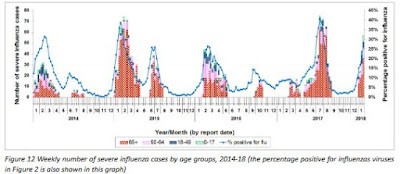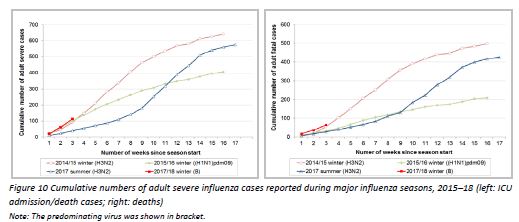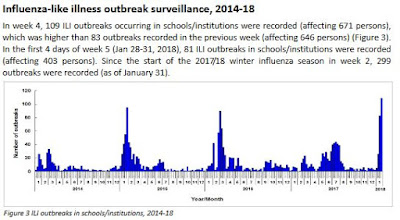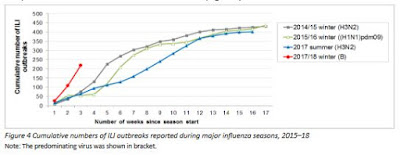#13,113
We watch flu reports from Hong Kong's CHP with particular interest because of their close proximity to Mainland China, and because they do such a good job of monitoring and reporting on infectious diseases.
Often, what happens with influenza in Hong Kong can give us an early warning as to what may be happening in Southern China.Barely 5 months after the end of a particularly severe summer wave of influenza A/H3N2, Hong Kong declared their winter flu epidemic season underway on January 10th (see severe flu cases chart above) - this time dominated by Influenza B (primarily Yamagata Lineage).
As we discussed yesterday (see Influenza B: A Virus Not To Be Underestimated) - while it may lack pandemic potential - influenza B infection can be every bit as serious as influenza A.
And Hong Kong's steep rise in severe cases and deaths in just 3 weeks illustrates that point.When you compare the first 3 weeks of this winter's influenza B outbreak to the first 3 weeks of the three previous influenza A seasons (see charts below), this winter's severe cases are on par (or slightly ahead) of the 2014-15 winter H3N2 epidemic, and tracking far ahead of both the 2015-16 winter season and last summer's H3N2 outbreak.
As a result, hospitals in Hong Kong have been slammed (see Hong Kong Hospitals Inundated By Flu Cases), blood donations have fallen to a critical level (see CHP report ), and the Hospital Authority has ordered additional flu vaccines (expected in early Feb.).
Institutional outbreaks have already reached levels not reported during any of the last four years.
Outbreaks in schools and residential homes are running roughly 3x's higher in the first three weeks than any flu season in the past 4 years. While it remains to be seen how `wide' or long lasting this flu season will prove to be, in its opening weeks this winter's epidemic has blown up to impressive heights.
Some more excerpts from today's Flu Express follow:
FLU EXPRESS
Flu Express is a weekly report produced by the Respiratory Disease Office of the Centre for Health Protection. It monitors and summarizes the latest local and global influenza activities.
Local Situation of Influenza Activity (as of Jan 31, 2018)
Reporting period: Jan 21 – 27, 2018 (Week 4)
(SNIP)
- The latest surveillance data showed that the local influenza activity continued to increase and remained at a high level. Currently the predominating virus is influenza B.
- Influenza can cause serious illnesses in high-risk individuals and even healthy persons. Given that seasonal influenza vaccines are safe and effective, all persons aged 6 months or above except those with known contraindications are recommended to receive influenza vaccine to protect themselves against seasonal influenza and its complications, as well as related hospitalisations and deaths.
- Apart from adopting personal, hand and environmental hygiene practices against respiratory illnesses, those members of the public who have not received influenza vaccine are urged to get vaccinated as soon as possible for personal protection.
Laboratory surveillance, 2014-18
Among the respiratory specimens received in week 4, the positive percentage of seasonal influenza viruses was 26.29%, which was above the baseline threshold of 10.7% and higher than 23.65% recorded in the previous week (Figure 2). The 1988 influenza viruses detected last week included 162 (2.14%) influenza A(H1), 94 (2.14%) influenza A(H3), 1676 (22.16%) influenza B and 56 (0.74%) influenza C.
(SNIP)
Severe influenza cases of all ages
• Since the start of the current winter influenza season in week 2, 158 severe influenza cases among all ages have been reported, including 83 deaths (as of January 31).
• Among patients with laboratory confirmation of influenza admitted to public hospitals in this season (from January 7 to 31), 1.5% of admitted cases died during the same episode of admission. So far, it was below the historical range between 1.9% (2015/16 winter season) and 3.3% (2015 summer season).
(SNIP)
Global Situation of Influenza Activity
Influenza activity continued to increase in the temperate zone of the northern hemisphere while in the temperate zone of the southern hemisphere activity was at inter-seasonal levels. Worldwide, influenza A accounted still for the majority of influenza
- In Mainland China (week ending Jan 21, 2018), the influenza activity in both southern and northern provinces was at the seasonal level for winter influenza season. The activity in northern provinces has been decreasing in the past two weeks while that in southern provinces is still on an increasing trend. In southern provinces, the proportion of ILI cases in emergency and outpatient departments reported by sentinel hospitals was 6.7%, higher than that reported in the previous week (6.0%) and those in the corresponding period in 2015-2017 (3.0%, 3.3%, 2.8%). In northern provinces, that proportion was 5.2%, lower than that reported in the previous week (5.5%) but higher than those in the corresponding period in 2015-2017 (3.6%, 3.5%, 3.4%). The proportion of influenza detections in the week ending January 21, 2018 was 47.0% (53.6% influenza A and 46.4% influenza B).
- In Macau (week ending Jan 27, 2018), the proportions of ILI cases in emergency departments among adults and children increased. The proportion of influenza detections was 54.9%, higher than 44.6% in the previous week.
- Taiwan (week ending Jan 27, 2018) was at the peak of the influenza season. In the week ending January 27, the proportion of ILI cases in emergency department was 14.64% which was above the threshold of 11.4%. The predominating virus was influenza B.
(Continue . . . )
- In Japan (week ending Jan 21, 2018), the influenza season has started in late November 2017. The average number of reported ILI cases per sentinel site markedly increased to 51.93 in the week ending January 21, 2018 from the previous week (26.44), which was higher than the baseline level of 1.00. The proportions of detection for influenza A(H1N1)pdm09 and B in the past five weeks were similar, then followed by influenza A(H3N2).



